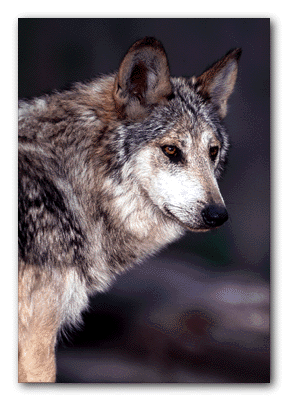MEXICAN WOLF
Canis lupus baileyi
Mammal
Order Carnivora
Description
Gray with light to dark brown back. 26-32 inches tall (at shoulder); 4.5 - 5.5 long feet in total- length (nose to tail). Adults 50 - 90 lbs. The Mexican wolf is the smallest subspecies of North American gray wolf.
Range
Once ranged over much of American southwest, and ranged from central and northern Mexico. Today their existence in the wild is uncertain as recent sightings are unconfirmed.
Endangered, Lincoln Park Zoo is a member of the Mexican Wolf Species Survival Plan.

 Ecology
Ecology
- Habitat
- Prefers montane woodlands because of the favorable combination of cover, water, and prey availability, but they were also found in arid habitats of the southwest.
- Niche
- Carnivorous: preys on deer, antelope, javelins, rabbits, small mammals as well as carrion and even refuse. Hunts cooperatively as packs to catch larger animals. Pack size smaller than northern wolves, probably as a function of lower prey density in arid habitats.
Life History
Mating in captivity usually occurs mid- February - mid-March- Gestation averages 63 days, births in Apr or May. One litter of 2-8 pups born each year- Mature at 1-2 yrs. Captive life span 12-15 yrs.
Special Adaptations
- Smaller size associated with warmer climate.
- Highly social- Sophisticated communication system from howling to scent marking to warn other packs or individuals of their presence and helps them Keep track of one another.
- Thick coal to protect the themselves from the colder climates.
- Large nose and keen sense of smell help animal detect prey as well as other wolves.
- Ears can turn to help pick up sound direction.
- Legs long enough for speed, while compact body is designed for endurance.
 Status
Status